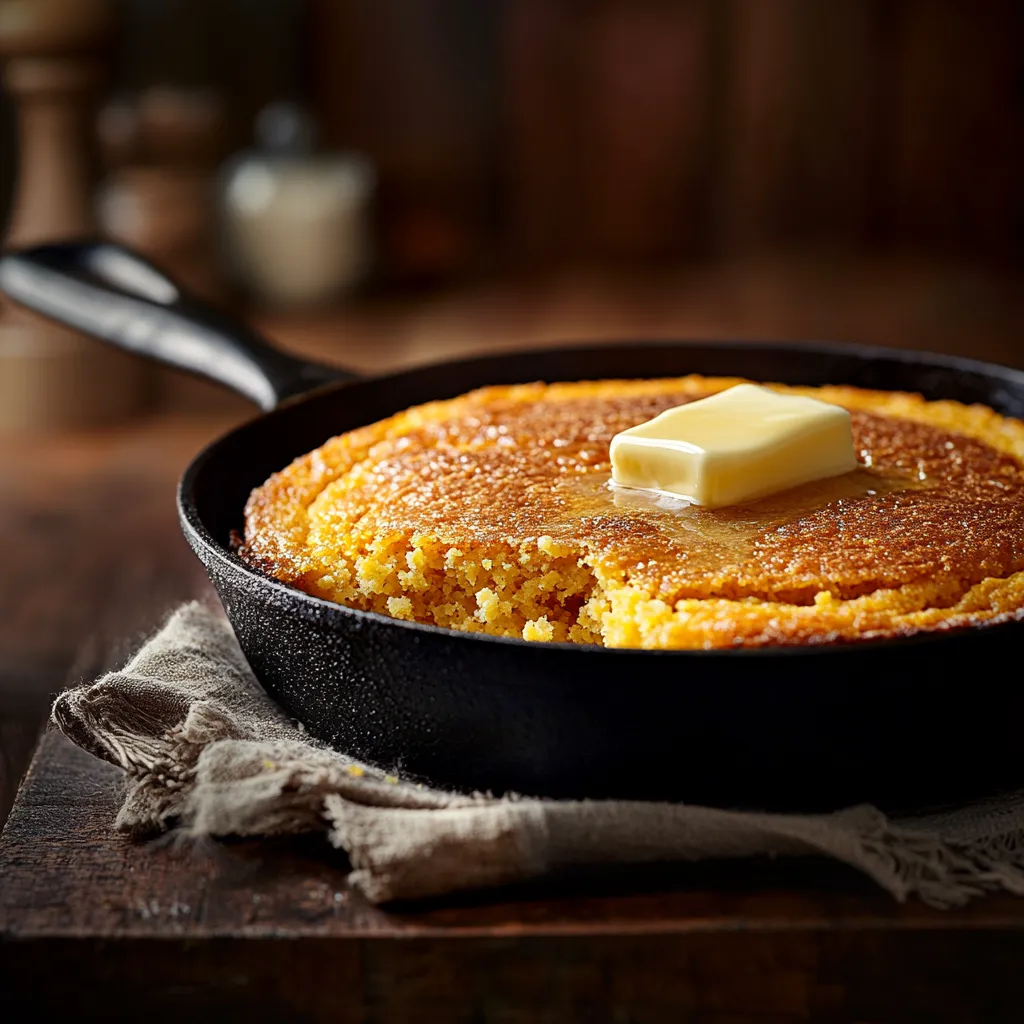Table of Contents
southern cornbread recipe is more than just a dish; it’s a cherished tradition steeped in history, flavor, and versatility. This savory bread, with its golden crust and tender crumb, has been a staple in Southern kitchens for generations. Whether paired with a hearty bowl of chili or enjoyed as a standalone delight, Southern cornbread captures the essence of comfort food.
In this guide, we’ll explore the history, essential ingredients, variations, and serving suggestions for creating the perfect Southern cornbread. Let’s dive into the secrets of this iconic recipe!
Introduction to Southern Cornbread
What Makes Southern Cornbread Unique?
Southern cornbread isn’t just regular cornbread. It’s all about simplicity, tradition, and taste. Unlike its sweeter Northern counterpart, authentic Southern cornbread skips the sugar and focuses on savory notes. The crispy edges and tender crumb make it irresistible, especially when baked in a well-seasoned cast-iron skillet.
Historical Roots of Cornbread in Southern Cuisine
The origins of Southern cornbread trace back to Native American tribes who used ground corn to create simple bread recipes. When settlers arrived, they adapted these techniques, using cornmeal as a staple ingredient due to its affordability and abundance. Over time, cornbread became synonymous with Southern living, embodying the resourcefulness and flavor of the region.
Key Characteristics of Authentic Southern Cornbread
True Southern cornbread is defined by its texture and flavor. It’s typically made with stone-ground cornmeal for a coarse, rustic feel. Buttermilk gives it a slight tang, while bacon grease or butter adds richness. The hallmark? That crispy, golden crust that only a cast-iron skillet can deliver.
Essential Ingredients for Southern Cornbread

The Role of Cornmeal: Stone-Ground or Fine?
Cornmeal is the backbone of any Southern cornbread recipe. Traditional recipes call for stone-ground cornmeal, which offers a coarse texture and a richer, nutty flavor. This type of cornmeal preserves the natural oils and nutrients of the corn, delivering a rustic, authentic taste. On the other hand, finely ground cornmeal creates a smoother texture but can lack the robust character that stone-ground varieties provide.
When selecting cornmeal, look for options labeled as “whole-grain” or “stone-ground” for the best results. Pairing high-quality cornmeal with a seasoned cast-iron skillet ensures the perfect balance of crunch and softness.
Why Use Buttermilk Instead of Milk?
The tangy kick of buttermilk is a signature element of Southern cornbread. Buttermilk not only enhances the flavor but also interacts with the baking soda to create a light, fluffy crumb. While regular milk can be used in a pinch, it lacks the acidity that makes buttermilk so essential.
For those who don’t have buttermilk on hand, a simple substitute can be made by adding one tablespoon of lemon juice or vinegar to a cup of milk. Let it sit for five minutes, and it’s ready to use!
Fat Choices: Bacon Grease vs. Butter
One of the secrets to authentic Southern cornbread lies in the choice of fat. Bacon grease is a traditional favorite, adding a smoky depth and helping to achieve that signature crispy crust. Butter, on the other hand, lends a rich, creamy flavor and can be used alongside bacon grease for a perfect balance.
Whichever fat you choose, ensure it’s hot when the batter is poured into the skillet. This step creates the crispy edges that make Southern cornbread unforgettable.
Step-by-Step Guide to Making Southern Cornbread
Prepping Your Cast-Iron Skillet
The magic of Southern cornbread begins with a well-seasoned cast-iron skillet. Preheat the skillet in the oven, and grease it generously with bacon grease, butter, or oil. The hot skillet ensures the batter sizzles immediately upon contact, creating that golden, crispy crust.
Mixing the Ingredients for a Perfect Batter
Start by whisking together the dry ingredients—cornmeal, a pinch of salt, and a leavening agent like baking powder or baking soda. In a separate bowl, combine the wet ingredients, including buttermilk, eggs, and melted fat. Slowly fold the wet mixture into the dry ingredients, being careful not to overmix. Overmixing can result in dense cornbread, which is a common pitfall.
Why the Oven Temperature Matters
Southern cornbread thrives in a hot oven, typically set at 400–425°F. This high temperature helps to develop the crispy crust while ensuring the center remains tender.
Bake the cornbread for 20–25 minutes, or until the top is golden brown and a toothpick inserted in the center comes out clean.
Baking Tips for a Golden, Crispy Crust
For an even crispier crust, sprinkle a thin layer of cornmeal onto the greased skillet before pouring in the batter. Letting the batter rest for 10 minutes before baking also allows the cornmeal to hydrate fully, improving the overall texture.
Popular Variations of Southern Cornbread
Adding a Touch of Sweetness: Yay or Nay?
One of the biggest debates in the world of southern cornbread recipes is whether to add sugar. Traditional Southern cornbread avoids sweetness, favoring a savory taste that complements hearty dishes like chili or collard greens. However, some modern variations add a hint of sugar or honey for those who prefer a slightly sweet twist.
If you enjoy a middle ground, try incorporating a tablespoon of sugar into the batter. It won’t overpower the classic savory flavor but will provide a subtle contrast.
Incorporating Jalapeños, Cheese, or Corn Kernels
For a spicier take, diced jalapeños can add a kick of heat to your cornbread. Shredded cheddar cheese brings a creamy richness, while fresh corn kernels provide bursts of natural sweetness and texture.
These additions work well for special occasions or when serving cornbread as a standalone dish. For a party-friendly version, pour the batter into a muffin tin for individual servings packed with flavor.
Gluten-Free and Vegan Southern Cornbread Options
Accommodating dietary preferences doesn’t mean sacrificing taste. Gluten-free southern cornbread recipes can be made using a blend of almond flour and gluten-free cornmeal. For a vegan option, replace buttermilk with a mixture of almond milk and apple cider vinegar, and use flaxseed as an egg substitute.
These alternatives ensure everyone at the table can enjoy this timeless dish.
Serving Southern Cornbread: Tradition Meets Creativity

Classic Southern Dishes That Pair with Cornbread
Southern cornbread is a natural companion to many traditional dishes. It pairs beautifully with slow-cooked pinto beans, gumbo, or fried chicken. The savory, crumbly bread acts as the perfect sponge for soaking up flavorful sauces and broths.
For breakfast, serve cornbread with scrambled eggs and a dollop of honey butter for a simple yet satisfying start to the day.
Transforming Cornbread Leftovers: Puddings and Stuffings
Don’t let leftovers go to waste—southern cornbread can be easily repurposed into delicious new dishes. Crumbled cornbread makes an excellent base for a savory stuffing, perfect for roasted chicken or turkey.
Alternatively, use the crumbs to create a sweet cornbread pudding. Combine crumbled cornbread with milk, eggs, sugar, and vanilla, then bake until golden and set. This dessert highlights cornbread’s versatility and is sure to impress guests.
For more delicious recipes, consider exploring other options on Aprecipes.com. Whether it’s hearty stews, casseroles, or desserts, you’re bound to find inspiration for your next meal.
Troubleshooting Common Cornbread Issues
Why Is My Cornbread Too Dry?
Dry cornbread is a common problem, often caused by overbaking or using the wrong ratio of wet to dry ingredients. To avoid this, monitor your baking time closely. Remove the cornbread from the oven as soon as the edges are golden brown and a toothpick comes out clean.
Adding a touch of sour cream, yogurt, or even creamed corn to the batter can also boost moisture without altering the classic flavor. Using buttermilk instead of regular milk is another way to enhance richness.
How to Fix a Dense or Soggy Texture
Dense or soggy cornbread often results from overmixing the batter or an improperly preheated skillet. Overmixing activates the gluten in the flour, which can lead to a heavy, gummy texture. To avoid this, mix the ingredients just until combined.
Additionally, always preheat your cast-iron skillet in the oven before adding the batter. This step ensures an even bake and helps achieve that signature crispy crust.
Maintaining the Perfect Crust Without Overcooking
The crispy crust is the hallmark of an authentic southern cornbread recipe. To achieve this without overcooking, ensure the skillet is well-greased and hot before pouring in the batter. You can also experiment with broiling the cornbread for the last 1–2 minutes of baking to add extra crispness to the top.
FAQs About Southern Cornbread
What is the difference between cornbread and Southern cornbread?
Traditional Southern cornbread is savory, made without sugar, and relies on buttermilk and bacon grease for its rich flavor. Northern cornbread, in contrast, is often sweeter and uses more flour for a cake-like texture. The hallmark of Southern cornbread is its crispy crust and tender, savory crumb.
Why do Southerners not put sugar in cornbread?
For many Southerners, cornbread isn’t meant to be sweet. Historically, it was a practical and affordable staple, designed to complement savory dishes like greens and beans. Adding sugar is often seen as straying from the traditional roots of southern cornbread recipes.
Is it better to use milk or buttermilk in cornbread?
Buttermilk is the preferred choice for Southern cornbread. Its tangy flavor not only enhances the taste but also reacts with baking soda to create a lighter, fluffier texture. If buttermilk isn’t available, you can substitute with milk and lemon juice or vinegar.
Should you let cornbread batter rest before baking?
Letting the batter rest for 10–15 minutes before baking allows the cornmeal to fully hydrate, resulting in a more tender texture. This step also helps the leavening agents activate, improving the rise and ensuring an even bake.
Conclusion: The Joy of Homemade Southern Cornbread
A Dish That Connects Generations
Southern cornbread is more than just a recipe; it’s a bridge that links past and present. This rustic dish tells the story of resourceful cooks who transformed simple ingredients into something extraordinary. Today, it remains a staple on Southern tables, cherished for its ability to bring people together.
Making cornbread from scratch is not only rewarding but also a way to connect with the rich traditions of Southern cooking. Whether you’re baking it to accompany chili, serving it alongside fried chicken, or simply enjoying it with butter and honey, cornbread is a dish that feels like home.
Encouragement to Experiment and Make It Your Own
While tradition is important, don’t hesitate to experiment with your southern cornbread recipe. Add your favorite mix-ins, try different types of cornmeal, or adapt it to fit dietary preferences. The beauty of cornbread lies in its adaptability, allowing you to make it your own while staying true to its essence.
For more inspiration and another classic take on Southern cornbread, check out this recipe from Allrecipes.
For those looking to expand their cooking repertoire, cornbread serves as a gateway to other Southern classics, from stews to casseroles. With a little practice and creativity, your cornbread could become a family favorite for years to come.

